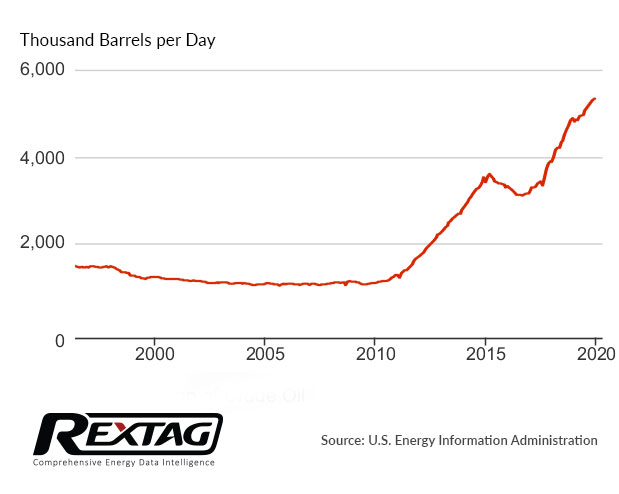Comprehensive Energy Data Intelligence
Information About Energy Companies, Their Assets, Market Deals, Industry Documents and More...
Texas Crude 2019 Production: Rigs Down, Production Up
05/07/2020
As you know the US Oil Rig Count has dropped by over 20% from January to December 2019. In Texas we saw oil rigs count dropping over 30% in that same time frame. However, the numbers show that the rig count has not affected oil production in a negative way.
We at Rextag have gathered some key facts about crude oil production in the US.
US crude oil production has reached a record level of 12.23 million barrels per day (b/d) in 2019. That is a 11% growth compared to the previous year. Crude oil production in 2018 was 10.9 million barrels per day.
The all time high in monthly oil production was reached in November 2019, when an average of 12.86 million b/d were produced in the United States.
In the past ten years, crude oil production in the US has registered a growth of over 220%. This is mostly due to production from tight rock formations developed using horizontal drilling and hydraulic fracturing.
Despite oil rig count dropping over 30% from January to December 2019, Texas crude oil production has hit an all time high in December 2019, with a production of 5.35 million b/d. Compared to the previous year, we have seen an increase of almost 660,000 b/d.
Since 2010, Texas crude oil production has registered a growth of over 330%, namely an increase in production by 3.9 million b/d.
In 2019, Texas accounted for 41% of US crude oil production. The Permian region is, as expected, what drives these numbers so high and will most likely keep Texas as the top oil producing state in the US.
Texas Field Production of Crude Oil

The Permian region has also boosted crude oil production in New Mexico, setting a new record for oil production in the state. Compared to 2010, there was a growth of 749,000 b/d.
Taking a look at the Offshore Federal Gulf of Mexico (the U.S. controlled waters in the Gulf of Mexico) we can also notice a production growth of 126,000 b/d in 2019. This has led to the Offshore Federal Gulf of Mexico’s highest annual average production of 1.88 million b/d.
Other states such as Colorado, North Dakota and Oklahoma have also reported a growth in production.
This increase in oil production was not however reported in all states. The oil production in Alaska has dropped for the second year in a row and also in California we can see a decline in production for the fifth year in a row.
If you are looking for more information about energy companies, their assets, and energy deals, please, contact our sales office mapping@hartenergy.com, Tel. 619-349-4970 or SCHEDULE A DEMO to learn how Rextag can help you leverage energy data for your business.
Corpus Christi and its O&G Infrastructure
![$data['article']['post_image_alt']](https://images2.rextag.com/public/HEMDS_SiteSupportFiles/BlogImages/Corp_Christi_LNG_Map.png)
Export Opportunities For Permian’s and Takeaway Problem
Top Crude Refineries Serving Permian
![$data['article']['post_image_alt']](https://images2.rextag.com/public/HEMDS_SiteSupportFiles/BlogImages/GoM_Refineries.png)
A total capacity for the area is as high as 8,576,325 Bcd according to Rextag count
![$data['article']['post_image_alt']](https://images2.rextag.com/public/blog/328_Blog_Why Are Oil Giants Backing Away from Green Energy Exxon Mobil, BP, Shell and more .jpg)
As world leaders gather at the COP29 climate summit, a surprising trend is emerging: some of the biggest oil companies are scaling back their renewable energy efforts. Why? The answer is simple—profits. Fossil fuels deliver higher returns than renewables, reshaping priorities across the energy industry.
![$data['article']['post_image_alt']](https://images2.rextag.com/public/blog/327_Blog_Oil Market Outlook A Year of Growth but Slower Than Before.jpg)
The global oil market is full of potential but also fraught with challenges. Demand and production are climbing to impressive levels, yet prices remain surprisingly low. What’s driving these mixed signals, and what role does the U.S. play?
![$data['article']['post_image_alt']](https://images2.rextag.com/public/blog/326_Blog_USA Estimated Annual Rail CO2 Emissions 2035.jpg)
Shell overturned a landmark court order demanding it cut emissions by nearly half. Is this a victory for Big Oil or just a delay in the climate accountability movement?